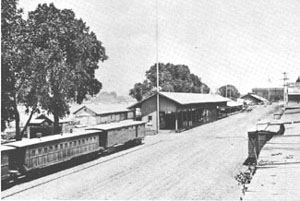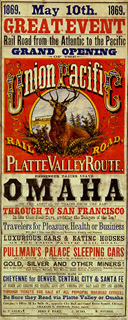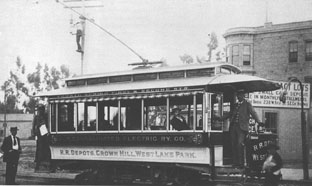Rail Transit Changes the West
Pioneer railroads provide link to river and ocean docks
 The
railroads revolutionized transportation in the west, slowly replacing ships, wagons and stage
lines. Making transportation faster, more economical and less difficult, the railroads aided
economic development, united California and Nevada with the rest of the nation, expanded the
American dream, and gave new freedom to Americans. Railroad workers became American folk heroes.
The
railroads revolutionized transportation in the west, slowly replacing ships, wagons and stage
lines. Making transportation faster, more economical and less difficult, the railroads aided
economic development, united California and Nevada with the rest of the nation, expanded the
American dream, and gave new freedom to Americans. Railroad workers became American folk heroes.
The discovery of gold in California brought miners to the Sacramento-Placer area. Transportation from the mines to the Sacramento River became increasingly important. Freight wagons and stagecoaches provided transportation to the mining camps. The first railroad in California, the Sacramento Valley Railroad, began hauling ore, food, goods and passengers between Placer and the river docks in Sacramento in 1855.
Growing commercial activity in Southern California created a need to improve transportation along the wagon road between Los Angeles and the harbor wharf in Wilmington. In 1869 the 22 mile long Los Angeles and San Pedro Railroad began service. Read more about the pioneer railroads in the East and early California railroads.
Rail lines link California directly with the East
 Linking California with the East by rail became possible with the passage of the Pacific Railroad
Act in 1862, chartering the Central Pacific to build from the West, and the Union Pacific
to build from the East. A golden spike was driven marking the completion of the first transcontinental
rail line at Promontory, Utah on May 10, 1869. Travel time from the East to San Francisco
was reduced from weeks or months to about one week. Farms, towns and cities were founded
and grew along the route. Read more about the first transcontinental railroad.
Linking California with the East by rail became possible with the passage of the Pacific Railroad
Act in 1862, chartering the Central Pacific to build from the West, and the Union Pacific
to build from the East. A golden spike was driven marking the completion of the first transcontinental
rail line at Promontory, Utah on May 10, 1869. Travel time from the East to San Francisco
was reduced from weeks or months to about one week. Farms, towns and cities were founded
and grew along the route. Read more about the first transcontinental railroad.
Southern California and the East were linked in 1876 with the opening of the Southern Pacific line between Los Angeles and San Francisco. Produce and manufactured goods could now be shipped reasonably and quickly. A land boom began.
Competition between railroads began in 1885 when the Santa Fe Route connected with its affiliated California Southern Railroad, which ran from San Diego, northward to Pinacate and San Bernardino. The area's freedom from transportation monopolies was assured. Prices dropped, a ticket from the Mississippi River, which had cost $125 was reduced to $25 or less by 1887. Read more about the second transcontinental railroad.
Short line railways were built connecting outlying mining, agricultural and lumber communities with the transcontinental lines; some were narrow gauge, some lasted only a few years. One of the first was the Virginia & Truckee, which connected the Virginia City mining district and Carson City with the transcontinental line at Reno in 1872. The Nevada County Narrow Gauge Railroad, which served the Grass Valley and Nevada City mining district, was completed in 1876. Read more about the shortline railroads.
Street Railways link residential neighborhoods with center of town
 City street railways began providing needed reasonable city transit as
many people moving to the growing western cities could not afford their
own wagon or carriage. With the development of street railways, people
could build homes and live a further distance from the center of town.
In San Francisco, the Market Street Railway began city service in 1860.
In San Jose the First Street Railroad Company began horse drawn streetcar
operation in 1872. In Los Angeles, the Spring and Sixth Street Railway
began operating horse drawn streetcars in 1874. San Diego and other cities
experienced similar beginnings.
City street railways began providing needed reasonable city transit as
many people moving to the growing western cities could not afford their
own wagon or carriage. With the development of street railways, people
could build homes and live a further distance from the center of town.
In San Francisco, the Market Street Railway began city service in 1860.
In San Jose the First Street Railroad Company began horse drawn streetcar
operation in 1872. In Los Angeles, the Spring and Sixth Street Railway
began operating horse drawn streetcars in 1874. San Diego and other cities
experienced similar beginnings.
Cable streetcars were first introduced in San Francisco in 1873 on the Clay Street Hill Railroad, making development of the formerly inaccessible hilltops possible. Cable streetcars began operating in Los Angeles on Second Street in 1885.
Electric streetcars began operating in Los Angeles along Pico Street in 1887 but soon failed. The Consolidated Electric Railway's West First Street route to Westlake Park successfully began service in 1891 making use of improved technology. This line became a part of the Los Angeles Railway in 1895. Electric streetcars provided faster, more frequent and dependable city service. Read more about the city streetcars.
Electric interurban railways connect cities and suburban towns
As electric rail transportation technology improved, electric railways extended past city limits to connect neighboring cities together. Interurban electric railway service, offered by the Pacific Electric, provided passenger and freight transportation to many points throughout Los Angeles, Orange, San Bernardino and Riverside Counties. Formed in 1901 by Henry E. Huntington and his associates, the PE grew to become the "Worlds Greatest Interurban." Suburban towns sprang up alongside the PE rails. It became possible to commute to work, school, stores, theaters or the doctor within minutes; or ride to the beach or the mountains on weekends. Similar electric railways connected communities in other areas. Read more about the interurban railways.
Interpretation Railroad History Train Technology Railroad Operation Museums & Heritage Railroads Railroads Today
![]() Text written by Richard Boehle for Orange Empire Railway
Museum. Photos UPRR, OERM, Huntington Library.
Text written by Richard Boehle for Orange Empire Railway
Museum. Photos UPRR, OERM, Huntington Library.
Entire web site copyright 2002-2013, DigitalNetExpress.com, Burbank, California.
